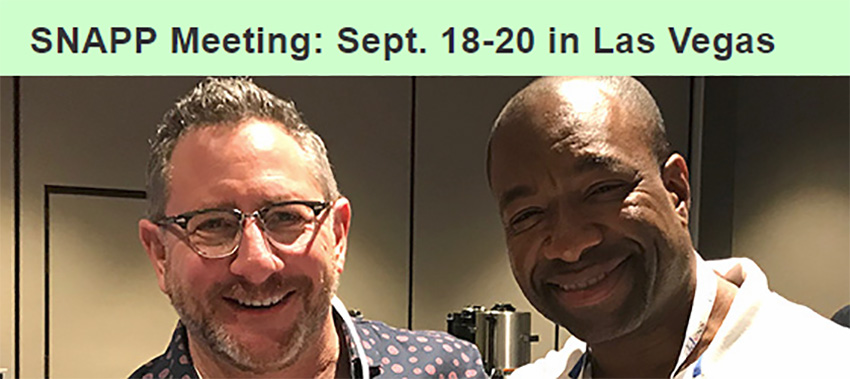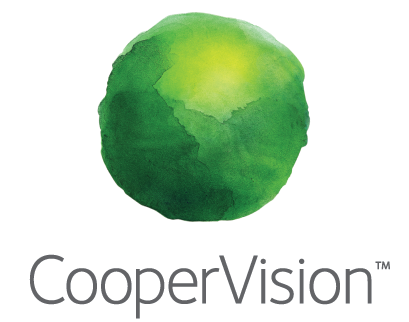
At SNAPP National Meetings, the mission and vision of the SNAPP Group truly come into focus. Pearle professionals gather together to share ideas, learn eagerly and hear from vendors firsthand about new products and services.
This truly is by design, as SNAPP has a “Three Tier Mission,” which includes group buying discounts, education (professional and business) and camaraderie. The result is that Pearle professionals can help each other become more successful by sharing best practices and business growth strategies.
This issue reflects the momentum as we approach the SNAPP Meeting in Las Vegas, Nevada, Sept. 18-20. Register here! You’ll see an updated agenda, registration and meeting information. Come see our “Three Tier Mission” in action.
Group Buying Discounts: SNAPP unites Pearle Vision professionals into one group to secure group buying discounts on lab equipment, ophthalmic medical equipment, contact lenses, payroll service, credit card processing and electronic health records.
Camaraderie: SNAPP provides a network of support to Pearle professionals to assist in sharing information on how to grow our businesses and become more profitable.
Education: SNAPP holds two annual meetings, which offer professional education for optometrists and opticians to meet their continuing education licensing requirements. These meetings will also offer business education including human resources training, readiness for Affordable Health Care Act, information on electronic health records, HIPAA compliance and ICD-10 changes.

Breaking a 7-Year Spell
Claude Cadet, licensed operator of Pearle Vision in Hialeah, Florida, had not been to a SNAPP National Meeting for seven years before coming to the spring meeting in New Orleans. “I wanted to hear the thoughts of other franchisees, especially in terms of trends in services, exams, patient visits and practice management issues,” he says.
He came away with new information and much more. “The accounting presentation alone was worth the trip; it was so relevant to everyone’s situation.” Cadet plans to attend the September meeting in Las Vegas as the meeting provides “a wealth of information that is precisely relevant to our offices,” he adds, noting he sent about 10 key slides from presentations back to the office for further discussion upon his return. Cadet is pictured above at right with Ken Kopolow, OD.

A Full Agenda
Here are a few highlights from the jam-packed agenda for our upcoming SNAPP Meeting in Las Vegas, to be held Sept. 18-20, 2019.
Wednesday | September 18, 2019
ABB Optical – Myopia Management | Andy Jackson | 3:10pm – 3:30pm
Combating Disruptive Forces in Eyecare – CE COPE/ABO | Michael Kling, OD | 5:20pm – 6:10pm
Thursday | September 19, 2019
How to Measure Financial Success – CE COPE/ABO | Steve Demko, OD | 8:00am – 8:55am
Compliance Update | Joe DeLoach, OD | 1:45pm – 2:00pm
Friday | September 20, 2019
Practice Management/How to create your practice of distinction – CE ABO/COPE | April Jasper, OD, FAAO | 8:00am – 9:50am
Nevus & Melanoma | Carlo Pelino, OD, FAAO | 11:00am – 12:00pm
Click here for the full agenda.

Conducting a “Stay Interview”
Tip of the Month from AmCheck
When employees leave, the exit interview can help you understand why. You may not be able to convince the departing employee to stay, but you may be able to make improvements that help you retain others.
But there’s another kind of employee interview—the “stay interview.” Like the exit interview, the stay interview solicits employee feedback; but instead of being conducted as an employee exits, it’s conducted before employees decide to leave. As the name implies, the stay interview asks employees why they stay.
For stay interviews to be effective, employees need to know they can trust the interviewer. Employers should be prepared to listen and make improvements based on what they learn. It’s helpful to reassure employees that their answers will not affect their performance reviews or result in any kind of retaliation.
Scheduling
Thirty minutes or less should be sufficient. Make sure you first ask the questions you most want answers to. If managers have regular one-on-one meetings with their employees, then conducting a stay interview once a year should be sufficient. In fact, a great way to start every regular one-on-one meeting is to ask how things are going for the employee. If you’re regularly chatting with employees about these matters—say once or twice a month—a separate stay interview might not be necessary. However, having HR conduct a separate stay interview can be helpful in cases where employees are not comfortable discussing these matters with their manager.
Executing
You may wish to open the interviews with a statement such as, “Thank you for meeting with me. I wanted to have an informal discussion about how your job is going, how you enjoy working here, and what we can do to support you. We value your feedback, and we want this to be a great place to work.”
Open-ended questions are best, as they can provide more actionable information. But it’s also important to limit your questioning to matters that are within your power to change. There’s no sense in asking if an employee is happy with their rate of pay if their rate of pay cannot be increased. Asking about pay in this case might give you additional information, but it’s likely to cause frustration on the employee’s part when nothing comes of their feedback.
Here are a few questions you might consider asking:
• What do you look forward to when you come to work each day?
• What do you like most or least about working here?
• What keeps you working here?
• If you could change something about your job, what would that be?
• What would make your job more satisfying?
• What would you like to learn here? What motivates (or demotivates) you?
• What can I do to best support you?
• What can I do more of or less of as your manager?
• What might tempt you to leave?
Closing, Documenting and Follow up
At the close of the stay interview, review the highlights of the discussion and let the employee know what to expect going forward. You might say something like, “Thank you for taking the time to meet with me and share this feedback. I am committed to doing what I can to address your concerns.” To ensure that you and the employee are on the same page about what was discussed during the stay interview (or regular check-in), take notes and share them with the employee afterwards. If any changes are made because of the employee’s feedback, be sure to let the employee know in the recap. Also let the employee know if any expected or desired changes couldn’t be made and why (if appropriate). Transparency is key, particularly as you won’t be able to fix everything or please everyone. Employees may not like the way everything is done, but if you share with them the reasons the company behaves the way it does, they’ll be more likely to trust you and share their concerns in the future.

Six Adjustment Codes Every OD Needs to Know

By Shane Shepherd, Sr. Insurance Sales Manager, VisionWeb
Insurance company remits can be confusing to read. Because they might differ slightly from payer to payer, the information on them can seem convoluted and ambiguous to the untrained eye. However, let’s apply the 80/20 rule. Actually, In the case of insurance, it’s more like the 99/1 rule. We’ll delve deeper into the commonly used adjustment codes, what they mean, and how you should be using them.
Insurance companies use standardized “adjustment codes” defined by the industry to indicate the status of processed claims. There are 301 adjustment codes available for payers to use. 301 different explanations for why a claim processed the way it did. You can see the full list here.
With so many different adjustment codes, it’s no wonder people feel a bit overwhelmed when they sit down to sort out what is going wrong (and right) with their billing department. However, the good news is that just six codes cover over 50 percent of all denials. If you learn how and why the following denials occur, you will have won more than half the battle.
Let’s take a look at the six most important codes every eyecare professional should know.
• 96 – Non-covered charges
• 204 – This service is not covered under the patient’s current benefit plan
• 49 – This is a non-covered service because it is a routine/preventative exam or a diagnostic/screening procedure done in conjunction with a routine/preventative exam.
These three adjustment codes are generally used by payers to indicate that there was NOT a routine benefit on the health plan. While reviewing more than 5,000 claims processed in the month of June, we found that 70 percent of the denials with these adjustment codes were for CPT code 92015 (refraction). The solution is to check your patient’s benefits for a routine CEE prior to seeing the patient. Overall, these three codes accounted for 30.9 percent of all denials.
• Adjustment code 109 is defined as: “Claim Service not covered by this payer/contractor. You must send the claim/service to the correct payer/contractor.” Most of the time, this denial occurs because of confusion over Medicare, Medicare Supplements, Secondary, and Medicare HMOs. (We’ll discuss this in more detail in next month’s newsletter.) These denials make up 7.4 percent of all denials. Yet again, checking the patient’s benefits correctly is the solution to this problem as well.
• Adjustment code 18 is defined as “Exact duplicate claim/service.” This category of denials makes up another 10.9 percent of overall denials. One needs to understand the difference between rejections and denials to avoid making this mistake. Please refer to last month’s article to learn how to file a corrected claim for a denial vs. resubmitting an original claim for a rejection.
• Lastly, we have adjustment code 16. This adjustment code is defined as “Claim/service lacks information or has submission/billing error(s). This reasoning makes up roughly 5 percent of all denials. It occurs most often because an ordering physician is not indicated in box 17 of Medicare claims. As you know, tests have to be ordered in the patient’s chart. For Medicare, this should also be indicated on the claim. If you see your OV codes paying regularly but your diagnostic tests are being denied, it is likely because of this issue.







